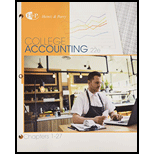
Bundle: College Accounting, Chapters 1-27, Loose-Leaf Version, 22nd + CengageNOWv2, 2 terms Printed Access Card
22nd Edition
ISBN: 9781305930421
Author: James A. Heintz, Robert W. Parry
Publisher: Cengage Learning
expand_more
expand_more
format_list_bulleted
Textbook Question
thumb_up100%
Chapter 17, Problem 6SEA
| Interest on $4,000, 90-day, 7% note (for 15 days) | $11.67 |
| Interest on $7,000, 60-day, 6% note (for 18 days) | 21.00 |
| $32.67 |
Expert Solution & Answer
Want to see the full answer?
Check out a sample textbook solution
Students have asked these similar questions
None
Give me solution
hello teacher please solve questions
Chapter 17 Solutions
Bundle: College Accounting, Chapters 1-27, Loose-Leaf Version, 22nd + CengageNOWv2, 2 terms Printed Access Card
Ch. 17 - The maturity value of a note includes both...Ch. 17 - Prob. 2TFCh. 17 - The difference between the maturity value of a...Ch. 17 - Prob. 4TFCh. 17 - When a dishonored note is collected, interest is...Ch. 17 - Principal plus interest equals ______ of a note....Ch. 17 - Prob. 2MCCh. 17 - Prob. 3MCCh. 17 - Prob. 4MCCh. 17 - Accrued interest payable is reported as a ______...
Ch. 17 - Prob. 1CECh. 17 - Prob. 2CECh. 17 - Prob. 3CECh. 17 - Prob. 1RQCh. 17 - Prob. 2RQCh. 17 - Prob. 3RQCh. 17 - Prob. 4RQCh. 17 - Prob. 5RQCh. 17 - Prob. 6RQCh. 17 - Prob. 7RQCh. 17 - Prob. 8RQCh. 17 - Prob. 9RQCh. 17 - On which notes receivable and notes payable is it...Ch. 17 - Prob. 11RQCh. 17 - When a business borrows money from a bank on a...Ch. 17 - What kind of account is Discount on Notes Payable,...Ch. 17 - Prob. 14RQCh. 17 - Prob. 15RQCh. 17 - TERM OF A NOTE Calculate total time in days for...Ch. 17 - Prob. 2SEACh. 17 - DETERMINING DUE DATE Determine the due date for...Ch. 17 - JOURNAL ENTRIES (NOTE RECEIVED, RENEWED, AND...Ch. 17 - Prob. 5SEACh. 17 - JOURNAL ENTRIES (ACCRUED INTEREST RECEIVABLE) At...Ch. 17 - JOURNAL ENTRIES (NOTE ISSUED, RENEWED, AND PAID)...Ch. 17 - JOURNAL ENTRIES (NOTE ISSUED FOR BANK LOAN)...Ch. 17 - JOURNAL ENTRIES (ACCRUED INTEREST PAYABLE) At the...Ch. 17 - NOTES RECEIVABLE ENTRIES J. K. Pratt Co. had the...Ch. 17 - NOTES RECEIVABLE DISCOUNTING Marienau Suppliers...Ch. 17 - ACCRUED INTEREST RECEIVABLE The following is a...Ch. 17 - NOTES PAYABLE ENTRIES Milo Radio Shop had the...Ch. 17 - ACCRUED INTEREST PAYABLE The following is a list...Ch. 17 - TERM OF A NOTE Calculate total time in days for...Ch. 17 - CALCULATING INTEREST Using 360 days as the...Ch. 17 - DETERMINING DUE DATE Determine the due date for...Ch. 17 - JOURNAL ENTRIES (NOTE RECEIVED, RENEWED, AND...Ch. 17 - JOURNAL ENTRIES (NOTE RECEIVED, DISCOUNTED,...Ch. 17 - JOURNAL ENTRIES (ACCRUED INTEREST RECEIVABLE) At...Ch. 17 - JOURNAL ENTRIES (NOTE ISSUED, RENEWED, AND PAID)...Ch. 17 - JOURNAL ENTRIES (NOTE ISSUED FOR BANK LOAN)...Ch. 17 - JOURNAL ENTRIES (ACCRUED INTEREST PAYABLE) At the...Ch. 17 - NOTES RECEIVABLE ENTRIES M. L. DiMaurizio had the...Ch. 17 - NOTES RECEIVABLE DISCOUNTING Madison Graphics had...Ch. 17 - ACCRUED INTEREST RECEIVABLE The following is a...Ch. 17 - Prob. 13SPBCh. 17 - ACCRUED INTEREST PAYABLE The following is a list...Ch. 17 - Prob. 1MYWCh. 17 - Rochelle needed to borrow 3,000 for three months...Ch. 17 - Eddie Edwards and Phil Bell own and operate The...Ch. 17 - Prob. 1CP
Knowledge Booster
Learn more about
Need a deep-dive on the concept behind this application? Look no further. Learn more about this topic, accounting and related others by exploring similar questions and additional content below.Similar questions
arrow_back_ios
SEE MORE QUESTIONS
arrow_forward_ios
Recommended textbooks for you
 College Accounting, Chapters 1-27AccountingISBN:9781337794756Author:HEINTZ, James A.Publisher:Cengage Learning,Principles of Accounting Volume 1AccountingISBN:9781947172685Author:OpenStaxPublisher:OpenStax College
College Accounting, Chapters 1-27AccountingISBN:9781337794756Author:HEINTZ, James A.Publisher:Cengage Learning,Principles of Accounting Volume 1AccountingISBN:9781947172685Author:OpenStaxPublisher:OpenStax College

College Accounting, Chapters 1-27
Accounting
ISBN:9781337794756
Author:HEINTZ, James A.
Publisher:Cengage Learning,

Principles of Accounting Volume 1
Accounting
ISBN:9781947172685
Author:OpenStax
Publisher:OpenStax College
7.2 Ch 7: Notes Payable and Interest, Revenue recognition explained; Author: Accounting Prof - making it easy, The finance storyteller;https://www.youtube.com/watch?v=wMC3wCdPnRg;License: Standard YouTube License, CC-BY